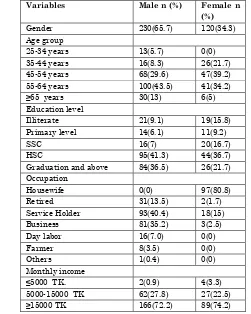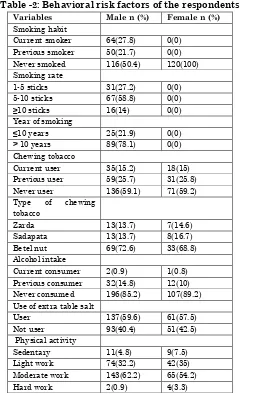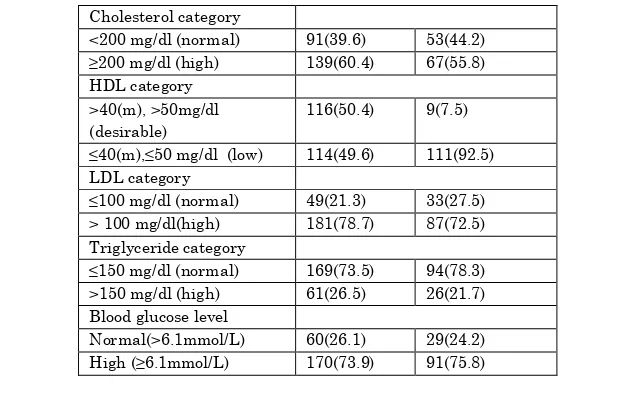ISSN 2286-4822
www.euacademic.org DRJI Value: 5.9 (B+)
Risk Factors of Stroke in Adult Population
MOHAMMAD SHAHADUR RAHMAN1
Monitoring Officer, USAID-DFID, NHSDP, SSKP Project, Sylhet
MD MONOARUL HAQUE
Chief Researcher, DPRC Specialized Hospital & Research Center
MONIRUZZAMAN
National Consultant-Injury & Disability Prevention WHO BAN NCD Unit, WHO Country Office for Bangladesh
MOHAMMAD DELWAR HOSSAIN
Senior Physiotherapist Jalalabad Ragib Rabeya Medical College, Sylhet
MD RAFIQUL ISLAM
Consultant, Alternative Medical Care
MD. JABEDUL ALAM KHONDAKER
Scientific Officer, National Forensic DNA Profiling Laboratory Dhaka Medical College
ABDUR RASHID
Research Officer, Training & Research Institute of Medicine, Acupressure and Nutrition (TRIMAN)
Abstract:
Background: Stroke is the second leading cause of death worldwide and the leading cause of long-term disability. A worldwide study based on vital record and data imputation shows that per year 15 million people faces the event ‘stroke’ which causes in 5 million deaths and a further 5 million patients living with permanent cognitive and physical disability. Objective: The aim of this study was to assess risk factors of stroke among adult population in Bangladesh.
of the male respondents (43.5%) were in 55-64 age groups and female participants (39.2%) constitute 45-54 age groups. About 58.9% study subjects had the habit of using extra table salt during their major meal. Nearly half of the respondents were overweight (46.9%) followed by normal (32%) and obese (21.1%). About 76.3% respondents were hypertensive (SBP ≥140, DBP≥ 90) and remaining was normal. Result shows that previous smoking habit have found significantly higher among the respondents with ischemic stroke (76%) compared to hemorrhagic stroke (24%), p<0.05. Chewing tobacco habit have found significantly higher in ischemic stroke (75.6%) compared to hemorrhagic stroke (24.4%), p<0.05. The intake of extra table salt have found significantly higher among the respondents with ischemic stroke (70%) compared to hemorrhagic stroke (30%), p<0.05. History of HTN have found significantly higher among the respondents with ischemic stroke (65.9%) compared to hemorrhagic stroke (34.1%), p<0.05. TIA have found significantly higher among the respondents with ischemic stroke (78.2%) compared to hemorrhagic stroke (21.8%), p<0.05.
Conclusion: High prevalence of HTN, DM, IHD and Dislipidemia among the stroke patients was found.
Key words: Risk factors, Stroke, Adult
Introduction
The global epidemic of stroke is not only the public health concern in high income countries. Nearly 85% of all stroke deaths are recorded in low- and middle-income countries, which results in 87% of total losses caused by stroke in terms of DALYs, measured, globally, in 72 millions per year1. Bangladesh is currently undergoing both epidemiologic and demographic transitions, where the decline in both fertility and mortality rates in early life have resulted in increased life expectancy. According to the estimation of the United Nations, life expectancy at birth is expected to increase to 74 years in
Methodology
Study design: The study was a descriptive type of cross sectional.
Place of study: The study was conducted in the indoor and outdoor of Department of Neurology ( Neuro medicine and surgery) in Dhaka Medical College and Hospitals (DMCH), Bangobondhu Sheikh Mujib Medical University (BSMMU), Bangladesh Institute of Research and Rehabilitation in Diabetes, Endocrine and Metabolic Disorders (BIRDEM), National Institute of Neuroscience and Hospital (NINH), Centre for the Rehabilitation of the Paralysed (CRP ) (Savar & Mirpur) in where strokes patient attended.
Study population: Adult stroke (age≥25) patients attended in indoor and outdoor of neurology (Neuro-medicine and surgery) department of DMCH, BSMMU, BIRDEM, NINH and CRP (Savar & Mirpur) were study population.
Sample size: In this study 383 participants were interviewed but due to some incomplete data 8.61% participants were excluded in data cleaning process. For that reason, information of 350 participants was finally selected for data analysis.
Sampling technique: The samples were selected purposively. The respondents who fulfilled the inclusion criteria and admitted in indoor and presented in outdoors of Neuro-medicine and surgery departments of DMCH, BSMMU, BIRDEM, NINH and CRP (savar, mirpur)
Data collection techniques: The interview was done in the outdoor and indoor department from stroke patient who attended in DMCH, BSMMU, BIRDEM, NINH and CRP (Savar & Mirpur) hospital in a suitable time for the respondent. Face to face interview was taken by using questionnaire and filling up checklists on observation in a comfortable environment in which the respondent could free to disclose their information. Before interviewing the patients, inform consent was taken. Relevant information was collected from medical record.
Results
History of HTN have found significantly higher among the respondents with ischemic stroke (65.9%) compared to hemorrhagic stroke (34.1%), p<0.05. History of IHD have found significantly higher among the respondents with ischemic stroke (57.6%) compared to hemorrhagic stroke (42.4%), p<0.05. TIA have found significantly higher among the respondents with ischemic stroke (78.2%) compared to hemorrhagic stroke (21.8%), p<0.05. Blood glucose level have found significantly higher among the respondents with ischemic stroke (64.4%) compared to hemorrhagic stroke (35.6%), p<0.05 (Table 4).
Table -1: Socio demographic characteristics of the respondents
Variables Male n (%) Female n (%)
Gender 230(65.7) 120(34.3)
Age group
25-34 years 13(5.7) 0(0)
35-44 years 16(8.3) 26(21.7)
45-54 years 68(29.6) 47(39.2)
55-64 years 100(43.5) 41(34.2)
≥65 years 30(13) 6(5)
Education level
Illiterate 21(9.1) 19(15.8)
Primary level 14(6.1) 11(9.2)
SSC 16(7) 20(16.7)
HSC 95(41.3) 44(36.7)
Graduation and above 84(36.5) 26(21.7) Occupation
Housewife 0(0) 97(80.8)
Retired 31(13.5) 2(1.7)
Service Holder 93(40.4) 18(15)
Business 81(35.2) 3(2.5)
Day labor 16(7.0) 0(0)
Farmer 8(3.5) 0(0)
Others 1(0.4) 0(0)
Monthly income
≤5000 TK. 2(0.9) 4(3.3)
5000-15000 TK 62(27.8) 27(22.5)
Table -2: Behavioral risk factors of the respondents
Variables Male n (%) Female n (%) Smoking habit
Current smoker 64(27.8) 0(0) Previous smoker 50(21.7) 0(0) Never smoked 116(50.4) 120(100) Smoking rate
1-5 sticks 31(27.2) 0(0) 5-10 sticks 67(58.8) 0(0)
≥10 sticks 16(14) 0(0)
Year of smoking
≤10 years 25(21.9) 0(0)
> 10 years 89(78.1) 0(0) Chewing tobacco
Current user 35(15.2) 18(15) Previous user 59(25.7) 31(25.8) Never user 136(59.1) 71(59.2) Type of chewing
tobacco
Zarda 13(13.7) 7(14.6)
Sadapata 13(13.7) 8(16.7)
Betel nut 69(72.6) 33(68.8) Alcohol intake
Current consumer 2(0.9) 1(0.8) Previous consumer 32(14.8) 12(10) Never consumed 196(85.2) 107(89.2) Use of extra table salt
User 137(59.6) 61(57.5)
Not user 93(40.4) 51(42.5)
Physical activity
Sedentary 11(4.8) 9(7.5)
Light work 74(32.2) 42(35) Moderate work 143(62.2) 65(54.2)
Hard work 2(0.9) 4(3.3)
Table -3: Physical and Biochemical findings
Variables Male n (%) Female n (%) BMI category
Normal(18.5-23 kg/m 2) 78(33.9) 34(28.3)
Overweight(23-27.5 kg/m
2)
108(47) 56(46.7) Obesity (≥ 27.5 kg/m 2) 44(19.1) 30(25)
Blood pressure
Normal 56 (24.3) 27(22.5)
Cholesterol category
<200 mg/dl (normal) 91(39.6) 53(44.2) ≥200 mg/dl (high) 139(60.4) 67(55.8) HDL category
>40(m), >50mg/dl (desirable)
116(50.4) 9(7.5) ≤40(m),≤50 mg/dl (low) 114(49.6) 111(92.5) LDL category
≤100 mg/dl (normal) 49(21.3) 33(27.5) > 100 mg/dl(high) 181(78.7) 87(72.5) Triglyceride category
≤150 mg/dl (normal) 169(73.5) 94(78.3) >150 mg/dl (high) 61(26.5) 26(21.7) Blood glucose level
Normal(>6.1mmol/L) 60(26.1) 29(24.2) High (≥6.1mmol/L) 170(73.9) 91(75.8)
Table -4: Association between type of strokes and variables of interest
Variables Type of stroke Chi-square
value p value Ischemic Hemorrhagic
Smoking habit
Current smoker 42(35.6%) 22(34.4%)
6.734 0.034
Previous smoker 38(76%) 12(24%) Never smoked 135(57.2%) 101(42.8%) 5-10 sticks 44(65.7%) 23(34.3%) > 10 sticks 14(87.5%) 2(12.5%) Year of smoking
≤ 10 years 22(88%) 3(12%)
.028 0.021
>10 years 58(65.2%) 31(34.8%) Chewing tobacco
11.084 0.004
Current consumer 27(50.9%) 26(49.1%) Previous
consumer 68(75.6%) 22(24.4%) Never consumed 120(58%) 87(42%) Type of chewing tobacco
Zarda 7(35%) 13(65%)
9.250 0.010
Sadapata 15(71.4%) 6(28.6%) Betelnut 71(69.6%) 31(30.4%) Alcohol consumption
Current consumer 2(66.7%) 1(33.3%)
15.831 0.001
Previous
Yes 144 (70%) 62 (30%)
15,176 0.001
No 71 (49.3%) 73 (50.7%)
Physical activity level
Sedentary 16(80%) 4(20%)
8.130 0.043
Light work 61(52.6%) 55(47.4%) Moderate work 135(64.9%) 73(35.1%)
Hard work 3(50%) 2(50%)
History of hypertension
Yes 174(65.9%) 90(34.1%)
34.425 0.001
No 21(32.8%) 43(67.2%)
Don’t know 20(90.9%) 2(9.1%) History of ischemic heart disease
Yes 106(57.6%) 78(42.4%)
6.566 0.038
No 88(62.4%) 53(37.6%)
Don’t know 21(84%) 4(16.9%) History of transient ischemic attack
Yes 79(78.2%) 22(21.8%)
17.310 0.001
No 133(55%) 109(45%)
Don’t know 3(42.9%) 4(57.1%) Blood glucose level
Normal 47(52.8%) 42(47.2%)
3.742 0.036
High 168(64.4%) 93(35.6%)
Discussion
Conclusion:
There are many risk factors for stroke, some are modifiable and some are non modifiable. This study also focus on some major modifiable lifestyle and behavioral pattern of Bangladeshi population such as smoking habit of male, chewing tobacco practice of both male and female, unhealthy diet practice, low level of physical activity and use of oral contraceptives. This study also focuses on some co-morbid condition of stroke such as Diabetes, Hypertension, Ischemic Heart Disease, Transient Ischemic Attack, Obesity and Dislipidemia. Study found that there is a high prevalence of HTN, DM, IHD and Dislipidemia among the stroke patients. Implementation of screening program in the community to identify risk factors and educate people about primary prevention should be initiated in this regard. This way, we can reduce morbidity and mortality among stroke patients and alleviate the burden of stroke.
REFERENCES
1. Mathers CD, Ezzati M, Jamison DT, Murray CJ, (2006). Global and regional burden of disease and risk factors, 2001: systematic analysis of population health data. Lancet, 367, 1747–57.
2. Population summary for Bangladesh international data base. Washington DC: US Census Bureau, 2010. (http://www.census.gov/population/international/
data/idb/country.php accessed on 27 June 2011).
(available at http://hcna.radcliffeoxford. com/bemgframe.htm).
4. McKeigue PM, Marmot MG, Syndercombe Court YD, Cottier DE, Rahman S, Riemersma RA. Diabetes, hyperinsulinaemia and coronary risk factors in Bangladeshis in East London. Br Heart J 1988; 60:390-6.
5. Bhopal R, Unwin N, White M, Yallop J, Walker L, Alberti KG, et al. Heterogeneity of coronary heart disease risk factors in Indian, Pakistani, Bangladeshi, and European origin populations: cross sectional study. BMJ 1999;319:215-20.
6. Erens B, Primatesta P, Prior G, eds. Health survey for England: the health of minority ethnic groups ’99. Vols 1, 2. London: Stationery Office, 2001:ix-633.
7. Mateen FJ, Carone M, Alam N, Streatfield PK, Black RE. A population-based case-control study of 1250 stroke deaths in rural Bangladesh. Eur J Neurol. 2012 Feb 16. doi: 10.1111/j.1468-1331.2012.03666.x.
8. Bhopal R, Rahemtulla T, Sheikh A. Persistent high stroke mortality in Bangladeshi Populations. BMJ 2005; 331; 1096-1097. doi:10.1136/bmj.331.7525.1096 .
9. Mohammad QD, Habib M, Hoque A, Alam B, Haque B, Hossain S, Rahman KM, Khan SU. Prevalence of stroke above forty years. Mymensingh Med J. 2011 Oct;20(4):640-4.
http://www.ncbi.nlm.nih.gov/pubmed/22081183.
10.Zaman MM, Nargis N Perucic AM, Rahman K. (editors) (2007). Impact of Tobacco-related illnesses in Bangladesh. SEARO, WHO, New Delhi.
12.Badiuzzaman M, Mohammed F R, Chowdhury F R, Bari M S, Alam m B, Ahasan H A M N. Prevalence of Modifiable Risk Factors among Stroke Patients in a Tertiary Care Hospital in Dhaka. J MEDICINE 2009; 10 (SUPPLEMENT 1): 18-21.
13.Bousser MG. Stroke in women. Circulation. 1999;99:463–467.
14.Hossain AM, Ahmed NU, Rahman M, Islam MR, Sadhya G, Fatema K. Analysis of Sociodemographic and Clinical Factors Associated with Hospitalized Stroke Patients of Bangladesh. Faridpur Med. Coll. J. 2011;6(1):19-23. 15.Chowdhury SGM, Ahmed Q, Dhan FD, Alam MR, Arif
SM, Roy PK. Stroke in patients having inadequate or irregular antihypertensive therapy. Bangladesh Med Res Coun Bull. 1990;16:53-20.
16.Dey SK, Ahmed S, Rahman KM, Uddin MJ, Alam MR, Bhattacharjee M, Mondal G, Israil A. Lipid profile among ischemic and haemorrhagic stroke patients. Mymensingh Med J. 2010 Apr;19(2):176-80.
17.Alamgir SM, Mannan MA. Cerebrovascular disease: A report of 53 cases. Bangladesh Med Res Coun Bull.1995;1:45-50.
18.Mohammad QD, Habib M, Hoque A, Alam B, Haque B, Hossain S, Rahman KM, Khan SU. Prevalence of stroke above forty years. Mymensingh Med J. 2011 Oct;20(4):640-4.
http://www.ncbi.nlm.nih.gov/pubmed/22081183.
19.Heart disease and stroke statistics -2005 update. Dallas: American Heart Association, 2005.
20.Brown RD, Whisnant JP, Sicks JD, O’Fallon WM, Wiebers DO. Stroke incidence, prevalence, and survival: secular trends in Rochester, Minnesota, through 1989. Stroke. 1996;27:373–380.
incidence and mortality: the Framingham Study. Stroke. 1992; 23:1551–1555.
22.Mollah AS, Rahman SW, Das KK, Hassanuzzaman M. Characteristics of patients admitted with stroke. Mymensingh Med J. 2007 Jan; 16(1):20-4. http://www.ncbi.nlm.nih.gov/pubmed/17344774.
23.Bashar A. A dessertation on "Study of risk factor of stroke" 1995: p. 78-80.
24.Chowdhury SGM, Ahmed Q, Dhan FD, Alam MR, Arif SM, Roy PK. Stroke in patients having inadequate or irregular antihypertensive therapy. Bangladesh Med Res Coun Bull. 1990;16:53-20.
25.Arif SM. A dissertation on study on risk factor for in Bangladesh. 1993.
26.Bamford J, Sandercock P, Dennis M, Warlow C, Jones L, McPherson K et al. A prospective study of acute cerebrovascular disease in the community: the Oxfordshire Community Stroke Project 1981-86. 1. Methodology, demography and incident cases of first-ever stroke. J Neurol.Neurosurg. Psychiatry 1988; 51:1373-80.
27.Ferri CP, Acosta D, Guerra M, Huang Y, Llibre-Rodriguez JJ, et al. Socioeconomic Factors and All Cause and Cause-Specific Mortality among Older People in Latin America, India, and China: A Population-Based Cohort Study. PLoS Med 2012 9(2): e1001179.
28.Chapman J. Epidemiology of vascular lesions affecting the central nervous system: The occurrence of stroke in a sample population under observation for cardiovascular disease. Am J Public Health 1966; 55:191-201.
30.Gill PS, Kai J, Bhopal RS, Wild S. Health care needs assessment: black and minority ethnic groups. In: Raftery J, ed. Health care needs assessment. The epidemiologically based needs assessment reviews. 3rd series. Abingdon: Radcliffe Medical Press (in press) (available at http://hcna.radcliffeoxford. com/bemgframe.htm).
31.American Heart Association. Heart Disease and Stroke Statistics – 2009 Update. Dallas, Texas: American Heart Association; 2009.
32.Perry IJ, Beevers DG. Salt intake and stroke: a possible direct effect. J Hum Hypertens. 1992; 6:23–25.
33.He J, Ogden LG, Vupputuri S, Bazzano LA, Loria C, Whelton PK. Dietary sodium intake and subsequent risk of cardiovascular disease in overweight adults. JAMA. 1999; 282:2027–2034.
34.Nagata C, Takatsuka N, Shimizu N, Shimizu H. Sodium intake and risk of death from stroke in Japanese men and women. Stroke. 2004; 35:1543–1547.
35.MacGregor GA, Markandu ND, Sagnella GA, Singer DR, Cappuccio FP. Double-blind study of three sodium intakes and long-term effects of sodium restriction in essential hypertension. Lancet. 1989; 2:1244–1247. 36.Wolf PA (1993). Contributions of epidemiology to the
prevention of stroke. Circulation 88:2471–2478. Gorelick PB (1995). Stroke prevention. Arch Neurol 32:347– 355. 37.Bassetti C, Aldrich MS, Chervin RD, Quint D. Sleep


